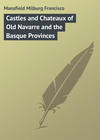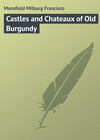Czytaj książkę: «Italian Highways and Byways from a Motor Car», strona 9
Tourists now come by dozens by road and rail to Subiaco – with a preponderance of arrivals by road – whereas a few years ago only a few venturesome artists and other lovers of the open knew its charms. Some day of course this charm will be gone, but it is still lingering on and, if you do not put on too great a pretense, you will get the same good cheer at five francs a day at “The Partridge” whether you arrive in a Mercédès or come as the artist does, white umbrella and canvases slung across your back. The proprietor of “La Pernice” has not as yet succumbed to exploiting his clients.
From Subiaco back to Rome via Tivoli is seventy kilometres and all down hill.
One can have no complete idea of Roman life without an acquaintance with the villas and palaces of Frascati and Tivoli. Tivoli was the summer resort of the old Romans. Mecenate, Horace, Catullus and Hadrian built villas there and enjoyed it, though in a later day it was reviled thus:
Tivoli di mal conforto – O piove, o tira vento, o suona a morto!
Tivoli may be said to have received its boom under the Roman nobles of the Augustan age who came here and set the fashion of the place as a country residence. Things prospered beyond expectations, it would seem, land agents being modest in those days, and by the time of Hadrian reached their luxurious climax.
Pope Pius II founded Tivoli’s citadel on the site of an already ruined amphitheatre in 1460. The Villa d’Este at Tivoli, built by the Cardinal Ippolito d’Este in 1549, is usually considered the most typical suburban villa in Italy. The house itself is an enormous pile, on one side being three stories higher than on the other. It is a terrace house in every sense of the word. Statuary, originally dug up from Hadrian’s villa, once embellished the house and grounds to a greater extent than now, but under the régime of late years many of these pieces have disappeared. Where? The palace itself is comparatively a modest, dignified though extensive structure, the views from its higher terraces stretching out far over the distant campagna.
Hadrian’s Villa, with its magnificent grounds, occupies an area of vast extent. According to Spartian, Hadrian, in the second century B. C., built this marvel of architecture and landscape gardening according to a fond and luxurious fancy which would have been inconceivable by any other who lived at his time. All its great extent of buildings have suffered the stress of time, and some even have entirely disappeared, as a considerable part of the later monuments of Tivoli were built up from their stones. Many of its art treasures were removed to distant points, many found their ways into public and private museums, and many have even been transported to foreign lands. The Italian government has now stopped all this by purchasing the site and making of it a national monument.
With Hadrian’s Villa is connected a sad remembrance. Piranesi, that accomplished and erratic draughtsman whose etchings and drawings of Roman monuments have delighted an admiring world, died as a result of overwork in connection with a series of measured drawings he was making of this great memorial of Rome’s globe-trotting Emperor.
CHAPTER XI
LA BELLA NAPOLI
SOUTH from Rome the highroad to Naples, and on down into Calabria, at first follows the old Appian Way, built by Appius Claudius in 312 B. C. It is a historic highway if there ever was one, from its commencement at Rome’s ancient Porta Capuana (now the Porta San Sebastiano) to Capua. As historic ground it has been excavated and the soil turned over many, many times until it would seem as though nothing would be left to discover. Enough has been found and piled up by the roadside to make the thoroughfare a continuous “sight” for many kilometres. Great churches, tombs, vineyards, cypress-wind-breaks and the arches of the Claudian aqueducts line its length, and if the automobilist is so minded he can easily put in a day doing the first twenty kilometres.
Velletri, thirty-six kilometres from Rome, is the first town of importance after passing Albano, practically suburban Rome.
Cisterna di Roma, a dozen kilometres further on, is a typical hill top town overlooking the Pontine Marshes below.
Terracina, on the coast, sixty-two kilometres beyond Velletri, is the border town between the north and the south, practically the limit between the extent of the Papal power and that of the kingdom of Naples.
Terracina sits at sea-level, and in all probability it is none too healthy an abode, though ten thousand souls call it home and seem content. It has a sea-view that would make the reputation of a resort, and the French and Italian Touring Clubs recommend the Hotel Royal, while the local druggist sells gasoline and oil to automobile tourists at fair rates – for Italy.
At Formia one may turn off the direct road and in half a dozen kilometres come to the coast again at Gaeta. The road from Formia runs through a picture paradise, and an unspoilt one, considering it from the artist’s point of view. Little more shall be said, though indeed it is not as at Sorrento or Capri, but quite as good in its way, and the Albergo della Quercia, at Formia, is not as yet overrun with a clientèle of any sort. This is an artists’ sketching ground that is some day going to be exploited by some one; perhaps by the artist who made the pictures of this book. Who knows?
Over another fragment of the Appian Way the highroad now continues towards Naples via Capua.
At Capua the road plunges immediately into a maze of narrow streets and one’s only assurance of being able to find his exit from the town is by employing a gamin to sit on the running board and shout destra or sinistra at each turning until the open country is again reached at the dividing of the roads leading to Caserta and Naples respectively.
The highroad from Capua into Naples covers thirty kilometres of as good, or bad, roadway as is usually found on entering a great city where the numerous manifest industries serve to furnish a traffic movement which is not conducive to the upkeep of good roads. It is a good road, though, in parts, but the nearer you get to “la bella Napoli” the worse it becomes, as bad, almost, as the roads in and out of Marseilles or Genoa, and they are about the worst that exist for automobilists to revile.
By either Averso or Caserta one enters Naples by the rift in the hills lying back of the observatory, and finally by the tram-lined Strada Forvia, always descending, until practically at sea-level one finds a garage close beside the Hotel Royal et des Étrangers and lodges himself in that excellent hostelry. This is one way of doing it; there are of course others.
The man that first said “Vedi Napoli e poi mori!” didn’t know what he was talking about. No one will want to die after seeing Naples. He will want to live the longer and come again, if not for Naples itself then for its surroundings, for Pompeii, Herculaneum, Sorrento, Capri, Amalfi, Vesuvius and Ischia. Naples itself will be a good place at which to leave one’s extra luggage and to use as a mail address.
The history of Naples is vast, and its present and historic past is most interesting, but for all that Naples without its environs would be as naught.
The local proverb of old:
“When Salerno has its port
Naples will be mort (dead),”
has no reason for being any more, for Naples’ future as a Mediterranean seaport is assured by the indefatigable German who has recently made it a port of call for a half a dozen lines of German steamers. Britain may rule the waves, but the German is fast absorbing the profitable end of the carrying trade.
Naples is a crowded, uncomfortable city, for within a circumference of scarce sixteen kilometres is huddled a population of considerably more than half a million souls.
Naples’ chief charms are its site, and its magnificently scenic background, not its monuments or its people.
“The lazzaroni,” remarked Montesquieu of the Neapolitan “won’t-works,” “pass their time in the middle of the street.” This observation was made many, many years ago, but it is equally true to-day.
Naples is not the only Italian city where one sees men live without apparent means of existence, but it is here most to be remarked. On the quays and on the promenades you see men and women without work, and apparently without ambition to look for it save to exploit strangers. On the steps of the churches you see men and women without legs, arms or eyes, and infants sans chemises, and they, too, live by the same idle occupation of asking for alms.
Everywhere at Naples, before your hotel, crowded around your carriage or automobile, or paddling around in boats just over your steamer’s side, are hoards of beggars of all sorts and conditions of poverty and probity. The beggar population of Naples is doubtless of no greater proportions than in Genoa, or even Rome, but it is more in evidence and more insistent. There are singing beggars, lame, halt and blind beggars, whining beggars, swimming beggars, diving beggars, flower-selling beggars and just plain beggars. Give to one and you will have to give to all – or stand the consequences, which may be serious or not according to circumstances. Don’t disburse sterilized charity, then, but keep hard-hearted.
Naples’ chief sights for the tourists are its museum, its great domed galleries and their cafés and restaurants, its Castello dell’Ovo and the Castel del Carmine.
The Castello dell’Ovo is out in the sea, at the end of a tiny bridge or breakwater, running from the Pizzofalcone, one of the slopes of the background hills of Naples running down to sea-level.
As a fortress the Castello dell’Ovo is outranked to-day by the least efficient in any land, but one of the Spanish Viceroys, in 1532, Don Pedro of Toledo, thought it a stronghold of prime importance, due entirely to its oval shape, which it preserves unto to-day. It is unique, in form at any rate.
Charles VIII of France, on his memorable Italian journeyings – when he discovered (sic) the Renaissance architecture of Italy and brought it back home with him – dismantled the castle and left it in its now barrack-like condition, shorn of any great distinction save the oval shape of its donjon. One is bound to remark this noble monument as it is from its quay that one embarks on the cranky, little, wobbling steamboat which bears one to Capri. Lucullus, who had some reputation as a good liver, once had a villa here on the very quay which surrounds the Castello.
Opposite the Villa del Popolo (near the Porta del Carmine), the People’s Park as we should call it, is a vast, forbidding, unlovely structure.
It was built in 1484 by Ferdinand I, but during Masaniello’s little disturbance it became a stronghold of the people. To-day it serves as a barracks – and of course as a military prison; all nondescript buildings in Italy may be safely classed as military prisons, though indeed the Italian soldiery do not look an unruly lot.
It is well to recall here that Masaniello, who gave his name to an opera as well as being a patriot of the most rabid, though revolutionary, type, failed of his ambition and died through sheer inability to keep awake and sufficiently free from anxiety to carry out his plans. Masaniello lost his head toward the end and got untrustworthy, but this was far from justifying either his murder or the infamous treatment of his body immediately after death by the very mob that the day before had adored him. His headless trunk was dragged for several hours through the mud, and was flung at nightfall, like the body of a mad dog, into the city ditch. Next day, through a revulsion of feeling, he was canonized! His corpse was picked out of the ditch, arrayed in royal robes, and buried magnificently in the cathedral. His fisherman’s dress was rent into shreds to be preserved by the crowd as relics; the door of his hut was pulled off its hinges by a mob of women, and cut into small pieces to be carved into images and made into caskets; while the very ground he had walked on was collected in small phials and sold for its weight in gold to be worn next the heart as an amulet.
The “Villas” of Naples are often mere maisons bourgeoises of modern date. Many of them might well be in Brixton so far as their architectural charms go.
Over in the Posilippo quarter, a delightful situation indeed, are innumerable flat-topped, whitewashed villas, so-called, entirely unlovely, all things considered. One of these, the Villa Rendel, was once inhabited by Garibaldi, as a tablet on its wall announces.
Garibaldi and the part that he and his red shirt played are not yet forgotten. Apropos of this there is a famous lawsuit still in the Italian courts, wherein the Garibaldian Colonel Cornacci, in accord with Ricciotti Garibaldi, son of the general, makes the following claim against the Italian government:
I. All the “tresor” (gold and silver) of the house of Bourbon.
II. Eleven millions of ducats taken from the Garibaldian government at Naples.
III. The Bourbon museum now incorporated with the National Museum.
IV. The Palace of Caserta and its park.
V. The Palace Farnese at Rome.
VI. The Palace and Villa Farnese at Caprarola at Naples.
VII. Two Villas at Naples, Capodimonte and La Favorita.
This is the balance sheet discrepancy resulting from the war of 1860 which the Garibaldian heirs claim is theirs by rights. It’s a mere bagatelle of course! One wonders why the Italian government don’t settle it at once and be done with it!
Naples is the birth-place of Polichinelle, as Paris is of Pierrot, two figures of fancy which will never die out in literature or art, a tender expression of sentiment quite worthy of being kept alive.
The Neapolitan, en fête, is quite the equal in gayety and irresponsibility of the inhabitant of Seville or Montmartre. The processionings of any big Italian town are a thing which, once seen, will always be remembered. At Naples they seem a bit more gorgeous and spontaneous in their gayety than elsewhere, with rugs and banners floating in the air from every balcony, and flowers falling from every hand. It is every man’s carnival, the celebration at Naples.
Leading out to the west, back of Posilippo, is the Strada di Piedigrotta, which is continued as the Grotto Nuovo di Posilipo, and through which runs a tramway, all kinds of animal-drawn wheeled traffic, and automobiles with open exhausts. All this comports little with the fact that the ancient tunnelled road along here was one of the marvels of engineering in the time of Augustus and that it led to Virgil’s tomb. This supposed tomb of Virgil is questioned by archæologists, but that doesn’t much matter for the rest of us. We know that Virgil himself has said that it was here that he composed the “Georgics” and the “Æneid,” and it might well have been his last resting-place too.
“Addio, mia bella Napoli! Addio!”
CHAPTER XII
THE BEAUTIFUL BAY OF NAPLES
“SEE Naples and die” is all very well for a sentiment, but when we first saw it, many years ago, it was under a grim, grey sky, and its shore front was washed by a milky-green fury of a sea.
Fortunately it is not always thus; indeed it is seldom so. On that occasion Vesuvius was invisible, and Posilippo in dim relief. What a contrast to things as they usually are! Still, Naples and its Bay are no phenomenal wonders. Suppress the point of view, the focus of Virgil, of Horace, of Tiberius and of Nero, and the view of “Alger la Blanche,” or of Marseilles and its headlands, is quite as beautiful. And the Bay of Naples is not so beautifully blue either; the Bai de la Ciotat in Maritime Province is often the same colour, and has a nearby range of jutting, jagged, foam-lashed promontories that are all that Capri is – all but the grotto.
The Bay of Naples has its moods, and there are times when its blueness is more apparent than at others; in short there are times when it looks more beautiful than at others, and then one is apt to think its charms superlative.
The praises of the ravishing beauty of the Bay of Naples have been sung by the poets and told in prose ever since the art of writing travel impressions has been known, but though the half may not have been told it were futile to reiterate what one may see for himself if he will only come and look. “A piece of heaven fallen to earth,” Sannazar has said, and certainly no one can hope to describe it with more glowing praise.
For the artist the whole Neapolitan coastline, and background as well, is a riot of rainbow colouring such as can hardly be found elsewhere except in the Orient. It is not only that the Bay of Naples is blue, but the greys and drabs of the ash and cinders of Vesuvius seem to accentuate all the brilliant reds and yellows and greens of the foliage and housetops, not forgetting the shipping of the little ports and the costuming of land-lubbers and sailor-men, and of course the women. The Italian women, young or old, are possessed of about the loveliest colouring of any of the fair women of the twentieth century portrait gallery.
The environs of Naples have two plagues which, when they rise in their wrath, can scarcely be avoided. One is the sirocco, that dry, stiff wind which blows along the Mediterranean coast in summer, coming from the African shore and the desert beyond, and the much worse, or at least more dreaded, aria cattiva, which is supposed to blow the sulphurous gases and cinders of Vesuvius down the population’s throats, and does to a certain extent.
Out beyond Posilippo, which itself is properly enough bound up with the life of Naples, lies Pouzzoles. The excursion is usually made in half a day by carriage, and automobilists have been known to do it in half an hour. The former method is preferable, though the automobilist is free from the rapacious Neapolitan cab driver and that’s a good deal in favour of the new locomotion. If only automobilists as a class wouldn’t be in such a hurry!
Pouzzoles has no splendid palaces but it has the remains of a former temple of Augustus in the shape of twelve magnificent Corinthian columns, built into the Cathedral of Saint Procule, and some remains of another shrine dedicated to Serapis. There are also the ruins of Cicero’s villa at Baies, a little further on. Mont Gauro, where the “rough Falernian” wine, whose praises were sung by Walter de Mapes, comes from, shelters the little village on one side and Mont Nuovo on the other, this last a mountain or hillock of perhaps a hundred and fifty metres in height, which grew up in a night as a result of a sixteenth century earthquake.
The Lake of Averno is nearby, a tiny body of water whose name and fame are celebrated afar, but which as a lake, properly considered, hardly ranks in size with the average mill-pond. With a depth of some thirty odd metres and a circumference of three kilometres its charms were sufficient to attract Hannibal thither to sacrifice to Pluto, and Virgil there laid the “Descent into Purgatory.” Agrippa, with an indomitable energy and the help of twenty thousand slaves, made it into a port great enough to shelter the Roman fleet. At Baies there is a magnificent feudal work in the form of a fortress-château of Pedro of Toledo (1538).
At the tiny port of Torregaveta, just beyond, one takes ship for Procida and Ischia, two islands often neglected in making the round of Naples Bay.
Procida, off shore three or four kilometres, and with a length of about the same, has a population of fifteen thousand, most of whom rent boats to visitors. Competition here being fierce, prices are reasonable – anything you like to pay, provided you can clinch the bargain beforehand.
Ischia is twice the size of Procida, twice the distance from the mainland and has twice the population of the latter. One might say, too, that it is twice as interesting. It is a vast pyramid of rock dominated by a château-fort dating from 1450. It looks almost unreal in its impressiveness, and since it is of volcanic growth the island may some day disappear as suddenly as it came. Such is the fear of most of the population.
A quick round south from Naples can be made by following the itinerary below. It can be done in a day or a week, but in the former case one must be content with a cinematographic reminiscence.

Some one has said that Vesuvius was a vicious boil on the neck of Naples. There is not much sentiment in the expression and little delicacy, but there is much truth in it. Still, if it were not for Vesuvius much of the charm and character of the Bay of Naples and its cadre would be gone for ever.
All around the base of the great cone are a flock of little half-baked, lava-burned villages, as sad as an Esquimaux settlement in the great lone land. This is the way they strike one as places to live in, though the artist folk find them picturesque enough, it is true, and a poet of the Dante type would probably get as much inspiration here as did Alighieri from the Inferno.
It has been remarked before now that Italy is a birdless land. The Renaissance poets sang differently, but judging from the country immediately neighbouring upon Vesuvius, and Calabria to the southward, one is inclined to join forces with the first mentioned authority. Not even a carrion crow could make a living in some parts of southern Italy.
So desolate and lone is this sparsely populated region towards the south that it is about the only part of Italy where one may hope to encounter the brigand of romance and fiction.
The thing is not unheard of to-day, but what brigands are left are presumably kidnappers for political purposes who wreak their vengeance on some official. The stranger tourist goes free. He is only robbed by the hotel keepers and their employees who think more of buona mano than anything else. A recent account (1907), in an Italian journal, tells of the adventures of the master of ceremonies at Victor Emmanuel’s court who was captured by bandits and imprisoned in a cave in that terra incognita back of Vesuvius away from the coast.
Newspaper accounts are often at variance with the facts, but these made thrilling reading. One account said that the kidnappers tore out the Marquis’s teeth, one by one, in order to force him to write a letter asking for ransom. As he still refused, lights were held to the soles of his naked feet.
The Marquis was lured from Naples to the neighbourhood of a grotto in the direction of Vesuvius, where he was seized by the brigand’s confederates.
“I was seized unexpectedly from behind,” said the Marquis in his version, “and after a sharp struggle with my unseen assailants was carried down into the grotto with Herculanean force and tightly bound.
“Then, liberating my right arm, the brigands fetched a lamp and writing materials, covering their faces with masks. Threatening me with instant death, the chief forced me to write a letter to my friends demanding that money be sent me forthwith. At the same time he took from me all my valuables and then disappeared, leaving me a prisoner with a guard before the entrance of my cave.”
The adventure ended harmlessly enough, and whether it was all a dream or not of course nobody but the Marquis knows. At any rate it has quite a mediæval ring to it.
Pompeii is remarkable, but it is disappointing. All that is of real interest has been removed to the Naples museum. Without its Forum and its magnificent temples and Vesuvius as a toile de fond Pompeii would be a dreary place indeed to any but an archæologist. It is a waste of time to view any restored historic monument where modern house painters have refurbished the old half-obliterated frescoes. The famous Cave Canem, too, the only mosaic that remains intact, has been twice removed from its original emplacement. Yes, Pompeii is a disappointment! It is too much of a show-place!
The most notable observation to be made with regard to the admirable architectural details of Pompeii is that they are all on a diminutive scale. The colonnade of the Forum, for instance, could never be carried out on the magnificent scale of the Roman Forum, and indeed, when modern architects have attempted to reproduce the façade of a tiny pagan temple, as in the Église de la Madeleine, or the Palais Bourbon at Paris, they have failed miserably.
The rival claims of the Hotel Suisse and the Hotel Diomede at Pompeii (to say nothing of that of the Albergo del Sol opposite the entrance to the Amphitheatre) make it difficult for the stranger to decide upon which to bestow his patronage.
The artists go to the Albergo del Sol, which is rough and uncomfortable enough from many points of view, and the tourists of convention go to one of the other two, where they are “exploited” a bit but get more attention. At any one of these hotels one can hire a horse to climb up the cone of Vesuvius, if one thinks he would like such rude sport, and prices are anything he will pay, about five or six francs, though it costs another two francs for a guide and another two francs for the ragamuffin who follows after and holds the horses while you explore the crater. If the latter was blacking boots in New York, even for a padrone, at five cents a shine, he would make more money and be counted out of the robber class. As it is he is a rank impostor and needless – provided you have the courage to refuse his services.
The contrast between Herculaneum and Pompeii is notable. Herculaneum was buried under thirty metres of liquid lava, but Pompeii was buried only roof-high under cinders. Herculaneum will some day be uncovered to the extent of Pompeii, and then it is probable the world will have new marvels at which to wonder.
The rewards from the excavation of Herculaneum may well be commensurate with the toil. It was an infinitely more important place than Pompeii, which was only a little country town without libraries or particularly wealthy inhabitants. Herculaneum, on the other hand, was the summer resort of wealthy Romans, who spent their lives in adorning their beautiful villas with the choicest work of Greek art. Pliny said that they had a mania for collecting Greek silver and other works of art, and at prices that would even make the wealthiest art connoisseurs of to-day pause for thought. Agrippina, among others, had her villa here. Herculaneum remains intact and undespoiled, as it was more than eighteen centuries ago.
From Pompeii to Sorrento via Castellamare is twenty-five kilometres.
Sorrento is, in summer, a bathing place for such of the Neapolitan high-life population as are not able to get far away from home. One properly enough attaches no importance whatever to the gay life of the boulevards, the cafés and the restaurants of Naples. It is the same thing as at Rome, Paris and London over again with all its silly flaneries, but here at Sorrento, or across the peninsula at Amalfi, life is less feverish and one may stroll about or indeed live free and tranquil from care in hotels, less luxurious no doubt than those of the Quai Parthenope, but offering a sufficient degree of comfort to make them agreeable to the most exacting.
The real winter birds of passage only alight here for a period of three or four weeks in January or February. After that it is delightful, except for the short period when it is given up to the crowd of tourists which invariably comes at Easter.
Sorrento is the great centre for all the charming region bordering upon the southern shore of the Bay of Naples. It is at once the city and the country. Its hotels are delightfully disposed amid flowering gardens or on a terrace overlooking the escarpments of the rock-bound coast. Six or seven francs a day, or eight or ten, according to the class of establishment one patronizes, and one finds the best of simple fare and comfort. Eight days or a fortnight one may roam about the neighbourhood at Sorrento, from Sant Agatha on a nearby height to Sejano Castellamare, Positano, Amalfi and finally Capri. There is hardly such a range of charming little towns and townlets to be found elsewhere in all the world.
Except for its restricted little business quarter the houses and villas of Sorrento are disposed on the best of “garden city” plans. Again a plague on a beauty spot must be admitted: mosquitoes will all but devour you here between mid-August and the end of October. The only safe-guard is to paint yourself with iodine, but the cure is as bad as the complaint.
The traveller in Italy learns of course to beware of coral, of white, pink and milky coloured coral. We had been afraid to even look at such ever since we had seen it being made by the ton in Belgium – and good looking “coral” it was.
Once the artist bought a string of the real thing at Tabarka in Tunisia, and once a friend who was with us on the Riviera di Ponente bought a necklet of what was called coral, at an outrageous price, of a wily boatman. It all went up in smoke (accompanied by a vile smell) ultimately, though fortunately it was not on the owner’s neck at the time. It was an injudicious mixture of gun-cotton, nitroglycerine or what not. It wasn’t coral; that was evident.
Now, when we walk out at Sorrento, no Graziella, her shoulders scintillating with ropes of coral, beguiles us into buying any of her family heirlooms. To sum up: the coral which is sold to tourists is often false; that which is fished up before your eyes from the sea is always so. Beware of the coral of Sorrento or Capri.
The trip to Capri is of course included in every one’s itinerary in these parts, and for that reason it is not omitted here, though indeed the famous grotto over which the sentimentally inclined so love to rave has little more charm than the same thing represented on the stage. This at any rate is one man’s opinion. It is most conveniently reached by boat from Sorrento.
The famous retreat of Augustus and the scene of the debauches of Tiberius will ever have an attraction for the globe-trotter, even though its romance is mostly fictitious. One may gather any opinions he chooses, and, provided he gathers them on the spot and makes them up out of his own imaginings, he will be content with Capri’s grotto; only he mustn’t take the guide-books too seriously.



















